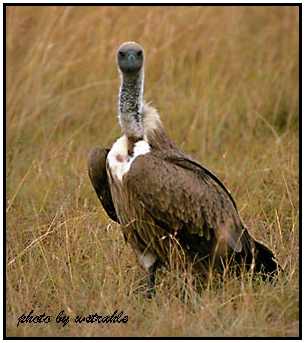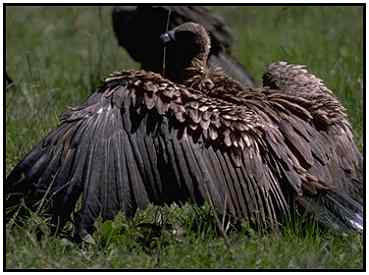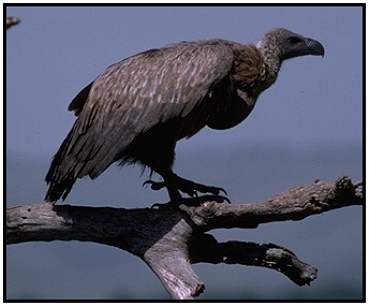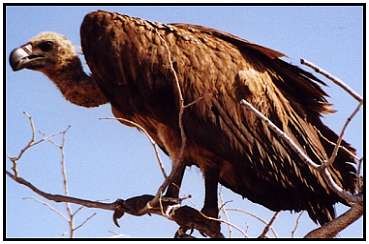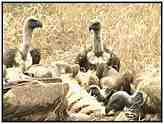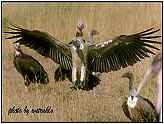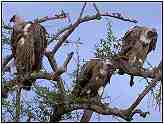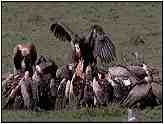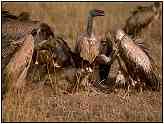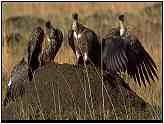African White-BackedOrder: Falconiformes. Family: Accipitridae. (Old World vulture). Scientific Name: Gyps africanus. Common Names: African White-backed Vulture.
African White-Backed Vultures (Photograph Courtesy of Bill Strahle Copyright ©2000)Conservation Status: Common. This is the most numerous of the African vulture species. Rescue & Recovery: None. Geographical Range: The more northern areas of Africa. Habitat: A tropical species and an inhabitant of the African plains, savannahs, and occasionally desert regions.
African White-Backed Vulture (Photograph Courtesy Gerald and Buff Corsi, California Academy of Sciences Copyright ©2000)Physical Characteristics: If this bird's white rump is not visible it is extremely difficult to separate from the Cape Vulture, a situation made even more difficult by the fact that their territories overlap. The tail feathers are dark whereas the lower wings are quite light in colour. Eyes are dark brown and the black skin of the head and neck is coated in a white or yellowish down. Dark limbs propel the birds across the plains during their very laboured takeoffs. The young have a darker body colour and the head and wings are spotted.
African White-Backed Vulture (Photograph Courtesy Gerald and Buff Corsi, California Academy of Sciences Copyright ©2000)Food: The African White-backed Vulture depends upon other smaller vultures to lead it to the site of a kill. In turn, once one African White-backed Vulture lands at a potential meal its obvious black and white plumage makes it readily visible to other birds which also join in the feast. In this way many birds are collectively covering a much wider area than would be possible for a single vulture. These vultures feed primarily upon large game, from hippopotamus that of died of natural causes, to wildebeest which drowned during migration, to elephants, rhinos and any other sizeable source of carrion. It is common to see up to two hundred birds feeding from one carcass, which explains how the corpse of an elephant can be stripped clean in just a matter of hours. After feeding they will frequently bathe to keep their feathers in prime condition. Despite their ghastly habits, vultures are one of the fussiest birds when it comes to cleanliness.
African White-Backed Vulture (Photograph Courtesy of Cliff Buckton (Copyright ©2000)Reproduction: May live singly or in colonies, but even single individuals tend to reside reasonably close to a main grouping of African White-backed Vultures. During mating season the vultures pair up and fly in giant leisurely circles, male and female so close together that their wing tips all but touch. Nests are built high in trees and up to six nests may be found per tree. Along a 208 kilometre stretch of the Uebi Shebeli river observers once counted 250 nests. During the dry season one egg is laid and incubated for around 43 days. The mother stays with the chick until it leaves the nest, with the father being responsible for feeding the entire family. Thumbnails (Click For Full-Size Image):
|

